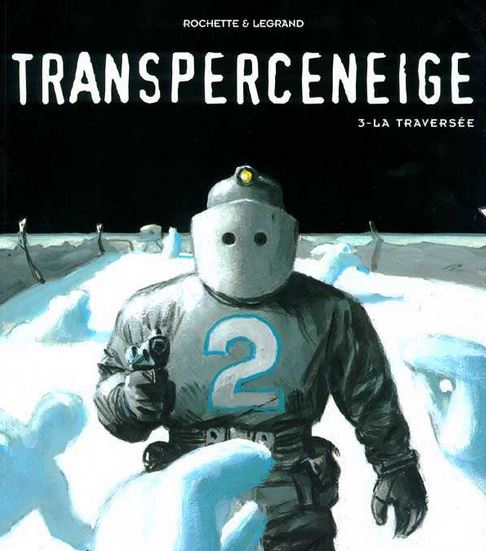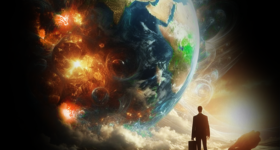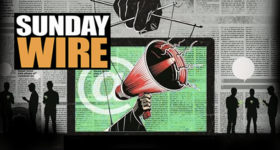 Jay Dyer
Jay Dyer
21st Century Wire
Snowpiercer stands out as a recent example of a trend fans of film are witnessing more of: philosophically-focused science fiction and fantasy.
While it could be argued that many science fiction classics deal with some philosophical themes, the trend has become far more common than in previous decades. In the last several years, films such as, After the Dark, The Double, Enemy, Another Earth, as well as many others, ask audiences to grapple with complex conundrums such as globalism, meaning and the self, morality and death, and even deeper esoteric questions, like alternate worlds and mystical symbology.
While Hollywood is busy with found-footage horror, cynical raunchy comedies and comic book blockbusters (the latter of which do incorporate conspiriana), lesser-known independent films are touching on far more abtruse matters that extend beyond the realm of the political. Seeing new films clearly influenced by Terry Gilliam, for example, is a welcomed beacon of hope. A rebellion in the arts – towards asking meaningful questions that challenge social engineering and prepackaged think-tank paradigms is precisely what is needed, and that is partly my intention with my work at Jay’s Analysis.

Le Transperceneige: The inspiration for cult Sci-Fi thriller Snowpiercer.
Based on the French graphic novel, Le Transperceneige, the film Snowpiercer is Korean filmmaker Bong Joon-ho’s first English release.
The plot involves a post-apocalyptic world that has entered a new ice age due to mankind’s failed geoengineering and climate-altering hubris. The amorphous chemical “CW7″ is sprayed globally to halt a supposed “global warming” catastrophe, while the ice age actually occurs as a result of the chemical spraying, and not anthropogenic global warming aka “climate change”.
To see a film present the very real threat of geoengineering and climate alteration through aerosol spraying, as well as questioning the “global warming” hoax (now morphed into “climate change” by public relations consultants) is startling to say the least. While there may be some film that has previously questioned these establishment orthodoxies, I am not aware of it. For unknowing skeptics and system hacks, I present two clear examples of the reality of aerosol chemical spraying (‘chemtrails’, as opposed to normal ice crystal ‘con-trails’) and geoengineering that are undeniable.

COMING OUT: Chemtrails and Geoengineering are central part of this Hollywood blockbuster.
The first is Bill Gates’ support for geoengineering, under the very auspices Snowpiercer questions – global warming. The Guardian reported in its 2012 article, ‘Bill Gates Backs Climate Scientists Lobbying for Large-Scale Geoengineering’:
“A small group of leading climate scientists, financially supported by billionaires including Bill Gates, are lobbying governments and international bodies to back experiments into manipulating the climate on a global scale to avoid catastrophic climate change. The scientists, who advocate geoengineering methods such as spraying millions of tonnes of reflective particles of sulphur dioxide 30 miles above earth, argue that a “Plan B” for climate change will be needed if the UN and politicians cannot agree to making the necessary cuts in greenhouse gases, and say the US government and others should pay for a major programme of international research.”
READ MORE ALTERNATIVE HOLLYWOOD NEWS AT: 21st Century Wire Hollywood Files
Skeptics are likely to claim this is only theoretical, inasmuch as the article reports on scientists merely calling for this, as opposed to it actually being accomplished. Such naiveté is common on these matters, as so-called skeptics perpetually display their own ignorance of establishment tendencies. Like the taunting of psychopathic criminals, whatever is “called for” in the news is generally what’s actually been practiced for a long while, and aerosol geoengineering and atmospheric manipulation is no exception. The technology is decades old, and began as weather warfare during World War II, where seasonal changes and storms could be harnessed to harm enemy resources through controlled droughts, floods, etc.
Earthquake weaponry also falls into this category, as well as biological waarfare, EMPs and HAARP, all falling under the broad umbrella of the concept of weaponized nature. However, for hardened skeptics, I refer to the even stronger example of the Stanford VLF Group, which openly publishes dozens of scientific papers on HAARP, atmospheric aerosol spraying, geoengineering, frequency manipulation, and other advanced research projects.
Snowpiercer begins with planes spraying the sky, while news casts report the importance of CW7 as the last hope to save humanity. As a result, virtually all life on earth perishes, while a small number of “chosen” are whisked away aboard a high-speed perpetual motion-run, ‘Free Energy’ powered train that continuously circles the globe. A perpetual motion machine is, in fact, a holy grail of technology, as its desire grew from the mechanistic model of the universe that gained sway in the Enlightenment. From the ‘Enlightenment’ came the reign of quantity and rationalization of all reality into the collapsed, reductionist grand narrative of evolutionary materialism. Within this paradigm, man is viewed as a cog in the deterministic, naturalistic machine of the inanimate, eternal and universal ecosystem. In this view, the symbiotic ecosystem requires an inchoate metaphysical principle of “balance,” and thus the Malthusian presuppositions of eugenics come into play, removing man from his previous position of ordained steward of creation under God, to an impersonal artifact on a social Darwinian ladder, who must ever grapple to become the fittest. The “fittest” then rapaciously destroy one another to subjugate and dominate nature en toto, in order to transcend it.
The culmination of this worldview is, of course, transhumanism, and Snowpiercer will become, as I argue, a warning for this worldview.

Korean actress Ko Ah-Sung in her role as Yo-Na in Snowpiercer.
Protagonist Curtis (Chris Evans) plays the revolutionary leader of the “back” of the train, who, under the tutelage of the aging former leader Gilliam (John Hurt), must organize the final rebellion against the tyrannical “front” of the train. Class warfare clearly comes to the fore, as the front of the train are all presented as decadent elite, wining and dining on the finest delicacies, enjoying every possible luxury a train can afford, while the workers at the back are forced by a brutal police state to produce for the parasitical front. Minister Mason (Tilda Swinton) heads up the front class’ security forces in a role reminiscent of something akin to Mao Tse Tung’s wife, Jiang Qing. Her communist dictator persona may seem out-of-place, given the monopolistic capitalism of the train’s demagogic inventor, Mr. Wilford (Ed Harris), yet regular readers will be familiar with the longtime argumentation presented here that communism and monopoly capitalism are flip sides of the same dialectical coin.
The corporate fascism of Wilford works hand in hand with the dictatorial militaristic police state polices of Minister Mason. It is also not accidental that her name is ‘Mason’, given the history of world freemasonry exhibits a clear proclivity for communism, from Robespierre and Marat to Salvador Allende. Communism and fascism are both political technologies designed to suit the same totalitarian ends.
As the ‘Curtis Revolution’ progresses, car by car, each compartment gives a new revelation of the dark nature of the system. The train’s unbending regimented eugenics policies and schoolhouse indoctrination programs emerge are the most significant, as viewers witness a classroom propaganda video portraying Mr. Wilford as a literal god and savior.
Here the film’s symbolism used to describe the train exemplifies an important deeper message. The train is compared symbolically three ways in the narrative: to a machine, to the world, and to a human body. Early on, as an angry worker loses his arm as a punishment, Minister Mason curiously describes the train as a body with a “head” and a “foot.” “Everything must stay in its preordained place,” she exclaims, as the foot trying to become the head leads to chaos, and chaos means the dissolution of mankind and loss of the train’s balanced ecosystem.
As the insurrection seizes the car associated with water production, a captive Minister Mason informs Curtis that water comes “from the mouth of the train, not the bum,” and that a resource war will harm all the train’s inhabitants. When Curtis reaches the front of the train, Wilford gives the descriptive imagery of the train as “an eternal machine” and as “the world,” but its significance will be detailed below.
While the revolution progresses, Curtis gradually begins to make tough moral choices that reveal more about his pragmatic designs to the viewer, as well as to himself. Curtis is forced to sacrifice his friend’s life to apprehend Minister Mason, then shoot Mason in the head, as well as admitting to cannibalism in the past to survive. Curtis slowly grasps that his own nature is quite cruel, calculating and vicious, and the difficulty of holding everyone to his egalitarian and equalitarian moral standards becomes more challenging. By the time Curtis reaches the front car and the engine, Wilford divulges the entire regime change was staged and engineered. Gilliam, the old revolutionary leader, is actually Wilford’s old friend, with a special direct phone line that communicates front to back. Gilliam and the revolution are then sacrificed by Wilford to maintain the 74% eco-balance for “sustainability.”
Wilford’s monologue then paints the train as the world, revealing to Curtis that all along the plan was to offer him leadership of the train, replacing Wilford. Since Curtis was the first worker to make a successful coup and reach the front, he was in a unique position to have seen the entire “machine” and its full hierarchical order, as no one else had. Wilford explains that the train must be ruled by “anxiety, fear and horror” in a balance to psychologically manipulate and control the masses. Meanwhile, the Curtis Revolution explodes into full anarchy and Wilford whispers to Curtis that without a hero, the train won’t run. “The eternal engine. It is eternity itself,” Wilford sneers, waiting for Curtis to accept the implications of his failed mutiny.
The crucial point in all this is the principle of managed dialectics – iconized in the communist revolutionary as a controlled creation of the engineers of the system (Wilford), whose aspirations are already calculated to serve elites in First Class when anxiety, subversion, chaos or depopulation, or eugenics – were needed. The phony left-right paradigm of Hegelian duality could not be better demonstrated. The train is a mini one world government built upon the industrial ingenuity of mass travel and global commerce, foreshadowing our own bleak dialectical future of a planetary regime.
Approaching the climax, Wilford hands Curtis a final secret message that reads “blood,” having previously sent “water,” which are basic elements of life and energy. They are also crucial components of the human body and its machinery, so we can make a connection here between the heart and the engine.
Curtis also discovers the ominous reality that the engine runs on the work of child slave labor, while Wilford sneers that the tail section supplies a steady stream of kids. The parasitical tyranny that is the train proves too much for Curtis, who opts to sabotage and derail it with the aid of the prophetic drug addict Nam and his daughter, Yona. However, Nam and Yona have discovered the great secret – the ice and snow are gradually melting, meaning there is the possibility of life outside the train. The real ecosystem is restoring its own balance, and man can be reconciled to it. As the train derails,. Nam and Curtis sacrifice themselves to shield Yona and a child from the explosion, and as a result, they become the last two survivors of humanity. Upon exiting the train, Yona spots a polar bear, meaning the existence of the train as the sole means for life and survival to be a farce. Whether intentional or not, we aren’t told, the myth of the impossibility of life outside the train was a farce. Although CW7 had brought an ice age, the principle of life triumphs over man’s technological dominance and alienation.
The great irony is that in Wilford’s doctrine of “everything in its place,” everything was out-of-place. Wilford had succumbed to the same irrational hubris that blinded pre-apocalypse humanity before the ice age.

Wilford’s Free Energy train engine.
On an esoteric level, there are elements of gnosticism throughout (and communism shares gnostic origins): Curtis is a kind of new man, destined to be the philosopher-king Wilford desired. Wilford’s revelation of the need for the “noble lie” of divine rulership to quell the masses echoes Plato’s Republic, which also curiously utilizes the symbology known as the “anthropic principle”.
The anthropic principle is the notion that observations about the physical universe bear some fundamental correlation and connection to human consciousness as its observer. In esoteric tradition, the anthropic principle extends as far as the idea that the human body itself is the microcosmic (microprosopus) mirror to the macrocosmic (macroprosopus) universe as a whole. Thus, in Plato’s Republic, the ideal republic is compared the body of man, while in his creation account, the Timaeus, this tradition replicates on the cosmic scale, comparing the universe to the body of a man. Curtis’ journey from the tail to the front may also symbolize the ascent of the soul in many traditions, particularly traditions that describe the soul after death passing through several gates or planetary “toll houses” to reach God, heaven or some blissful afterlife. Having forgotten his former life before the train, Curtis’ journey also echoes the Platonic doctrine of the soul’s migration from embodied particularity back to the One, from which all being flows. Curtis can be viewed on this level as the enlightened philosophic or religious soul seeking to escape the illusory reality the platonic demiurge has imposed upon the senses through the veil of materiality and flux.
In a world where man has acquiesced to allow his technological lust to outweigh his wisdom, the dangers of bare gnosis without wisdom become apparent. Snowpiercer asks us to ponder this profound question, and consider scientism’s past mistakes and blunders that have not led to human apotheosis, but mass death and self-destruction. Is large-scale geoengineering, tampering with the ecosystem under phony Malthusian sustainability and eugenically-regimented population control not itself the cause for much of the misery, chaos and alienation man experiences in his modern technocratic, quantification-obsessed existence?
Snowpiercer answers in the affirmative, and the film displays this wise message in a skillful and sophisticated form that makes it stand out in its craft. Can we exit crazy-train before crazy-train suffers a train wreck?
21WIRE contributor and author Jay Dyer is commentator on media, art, philosophy and culture. This article and many others, along with Jay’s podcast archive can be found on his blog Jay’s Analysis.
READ MORE ALTERNATIVE HOLLYWOOD NEWS AT: 21st Century Wire Hollywood Files
–














